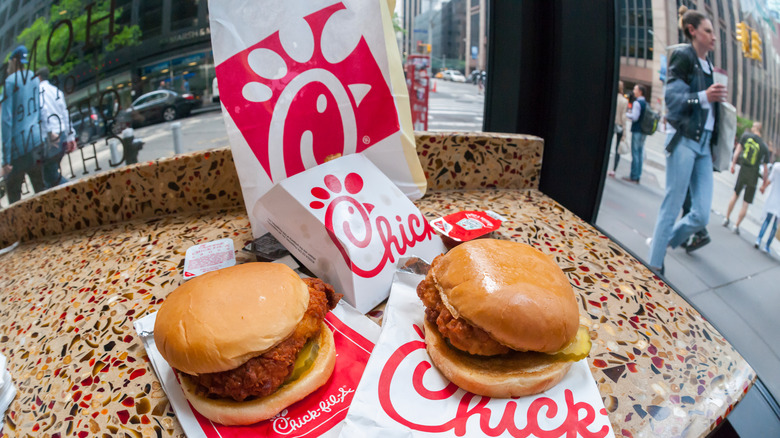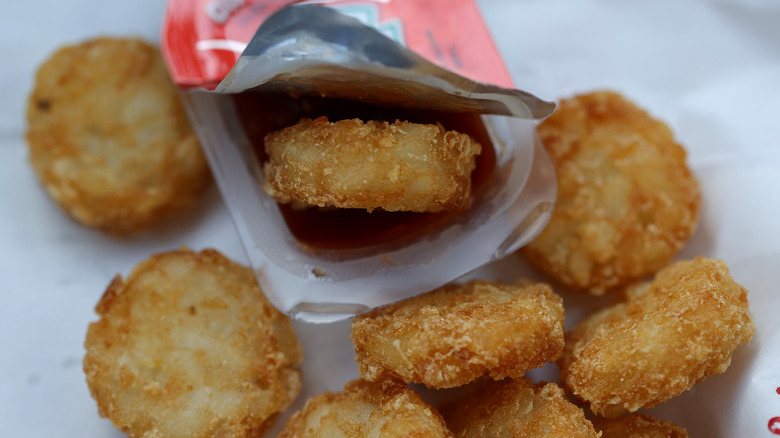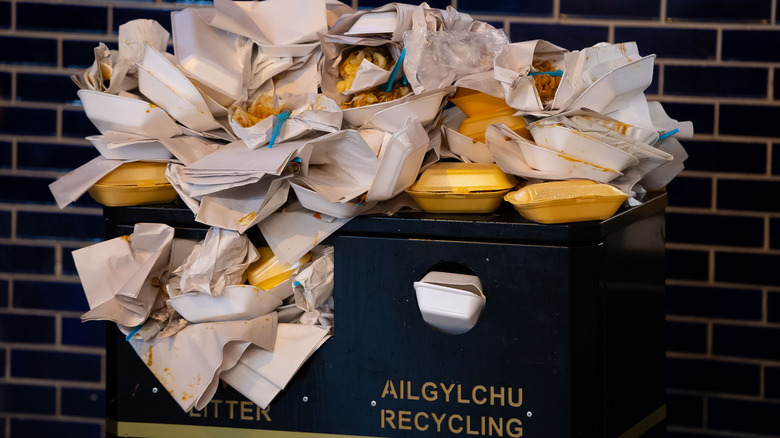This Employee Video Is Sending Chick-Fil-A Fans Into An Uproar
On May 22, an employee of Chick-fil-A uploaded a video to TikTok titled, "What they do every night with the chicken nuggets," and it shows a worker dumping an entire tray full of the bite-sized treats into a trash bin.
The video has since gone viral with 7 million views and counting. And commenters, as you may imagine, have been appalled at the amount of food waste – Fox News even picked up the story as the uproar surged. One person wondered why the food wasn't able to be given to the homeless community. But considering that it's meat, which is perishable — and not something more shelf-stable like a donut — other commenters chimed in that it would make people sick to eat food that's been sitting out that long and would be a liability to the restaurant chain.
The actual reason, as provided by Lovvett Blog, is that food banks cannot take already cooked food. So, Chick-fil-A can donate their surplus of uncooked chicken nuggets, but not the ones that have already been prepared for potential customers. However, there is nothing stopping the company from offering those cooked nuggets for free towards the end of the night when they are closing up shop.
Other people expressed sadness that such treasures of chickeny goodness would have to go to waste — just watching the video and seeing the scores of nuggets cascade, is rather, well, fowl.
Chick-fil-A has a program to donate food
In their coverage of the viral video, Daily Dot notes that Chick-fil-A did in fact create a Shared Table Program in 2012 to address these issues, whereby they donate the unused food to local organizations including soup kitchens, nonprofits, and homeless shelters. On their corporate website, Chick-fil-A explains that the Shared Table Program succeeds by having their workers package the restaurant's extra food to send to partner organizations, which then serve it to those in need.
More than 1,300 Chick-fil-A locations participate in the program and 8 million meals have been served through these donations, says Chick-fil-A, but Daily Dot notes a 2013 survey by the Food Waste Reduction Alliance, which found that, in general, just 1.4% of food from restaurants ends up being donated for various reasons, so it's unclear how effective programs like Shared Table are. In fairness, the lack of accurately reporting the donations could be chalked up to responsibilities between independent franchisees and the parent company that launched the initiative. Moreover, the waste in this particular viral video could be the practice of just one specific Chick-fil-A restaurant and not the chain as a whole.
It appears Chick-fil-A did not respond to various requests for comment on this story, further leaving viewers to ponder over the viral video that shows food waste in action. Hopefully the exposure leads to a bigger look into what can be done about putting all food to use for those in need.
Chick-fil-A is not the only restaurant in question
While the video is undoubtedly a bad look for Chick-fil-A, the brand should not bear the brunt of the outrage alone. As recently as 2017, Move For Hunger, a non-profit dedicated to fighting food scarcity and unnecessary waste, relayed reports that 85% of all food left unused in most American restaurants is discarded, rather than being recycled or donated. Even more alarming, the site calculated that a half-pound of food is wasted for every restaurant meal. That's millions of pounds that could otherwise be utilized every year for the reported 42 million people facing food insecurity in the country.
Of course, the gravity of the situation doesn't always take the attention of the customer. In 2019, Statista shared a graph demonstrating this phenomenon — the site noted, that of the thousand adults surveyed for the study, 81% said they either never thought about food waste while eating out or only thought about it sometimes, presumably when they've had such a large meal that they could neither finish it nor bring it home.
In Chick-fil-A's case, as with most fast food restaurants, the waste is predominantly from pre-cooked meals. The only way to really tackle this problem is by finding more innovative ways of getting rid of those un-purchased nuggets, or by transitioning to a made-to-order model, which may hinder the very fast service of a fast food restaurant. So, while the Chick-fil-A video is astounding to watch, it is our dining culture that perhaps needs a greater look.


